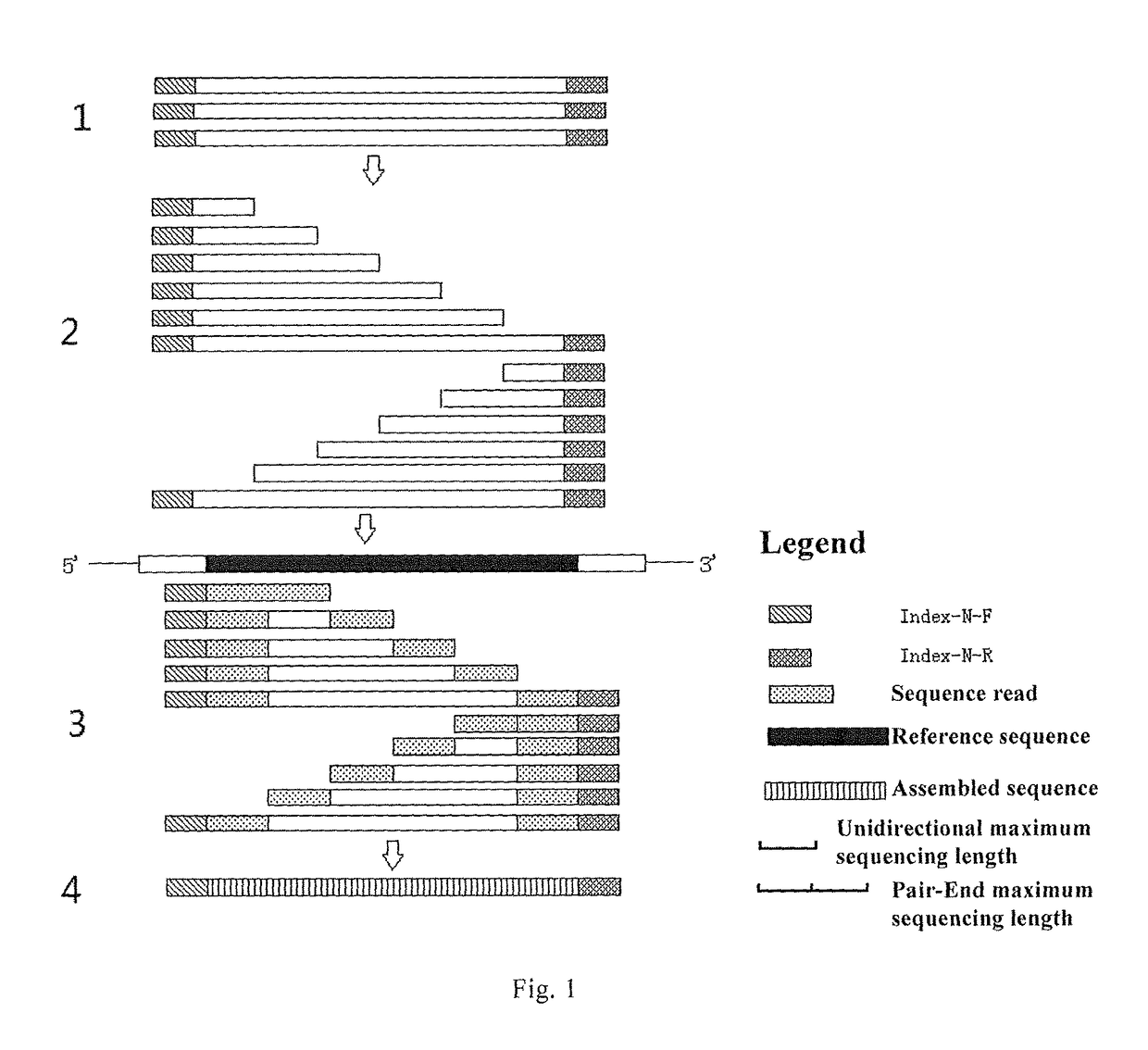Application of a PCR sequencing method, based on DNA barcoding technique and DNA incomplete shearing strategy, in HLA genotyping
a pcr sequencing and dna barcoding technology, applied in the field of nucleic acid sequencing, can solve the problems of scarification of cost and throughput of first generation sequencers, and achieve the effects of enhancing hla genotyping throughput, reducing cost, and good specificity and conservation
- Summary
- Abstract
- Description
- Claims
- Application Information
AI Technical Summary
Benefits of technology
Problems solved by technology
Method used
Image
Examples
example 1
[0149]Sample Extraction
[0150]DNAs were extracted from 95 blood samples with known HLA-SBT typing results (China Marrow Donor Program cited hereafter as (CMDP)) by using KingFisher Automatic Extraction Instrument (US Thermo Co.). The main steps were as followed: as directed in the handbook, a certain amount of self-contained agents was added to six deep-well plates and one shallow-well plate equipped by the KingFisher Automatic Extraction Instrument, and all the plates, to which the agents were added, were placed in the corresponding positions as required. The program “Bioeasy_200 ul Blood DNA_KF.msz” was selected, and was implemented to extract nucleic acids by pressing “star”. Approximately 100 μl eluted products (i.e. the extracted DNA) were collected from plate Elution after the program was finished.
example 2
[0151]PCR Amplification
[0152]Different PCR index primers were made by synthesizing PCR primers having different primer indexes at 5′ end, and such different PCR index primers may be applied to different samples, wherein the PCR primers were PCR primers for Exons 2, 3, 4 of HLA-A / B and Exon 2 of HLA-DRB1. Thereafter, primer indexes were introduced to the two termini of the PCR products by PCR reaction, thereby specifically labeling the PCR products from different samples.
[0153]95 sets of PCR index primers were used to amplify 95 DNA samples, respectively, wherein each set of PCR index primers consisted of a pair of bidirectional primer indexes (Table 6) and PCR primers for amplification of Exons 2, 3, 4 of HLA-A / B (Table 1) and of Exon 2 of HLA-DRB1 (Table 7), each forward PCR primer has the forward primer index in the pair of primer indexes linked at the 5′ end, and the reverse PCR primer has the reverse primer index in the pair of primer indexes linked at the 5′ end. During the syn...
example 3
[0167]Pooling and Purification of PCR Products
[0168]20 μl of the rest PCR products was taken from each well of the 96-well plate HLA-P-A2 (except for the negative control), and was mixed homogeneously under shaking in a 3 ml EP tube (designated as HLA-A2-Mix). The same operation was applied to the other 6 96-well plates, designated as HLA-A3-Mix, HLA-A4-Mix, HLA-B2-Mix, HLA-B3-Mix, HLA-B4-Mix and HLA-D2-Mix. 200 ul was taken from each of HLA-A2-Mix, HLA-A3-Mix, HLA-A4-Mix, HLA-B2-Mix, HLA-B3-Mix, HLA-B4-Mix and HLA-D2-Mix, and was mixed in a 3 ml EP tube, designated as HLA-Mix. 500 ul DNA mixture from HLA-Mix was subjected to column purification with Qiagen DNA Purification kit (QIAGEN Co.) (For the specific purification steps, please refer to the manufacturer's instruction). It was determined by Nanodrop 8000 (Thermo Fisher Scientific Co.) that the 200 ul DNA obtained by purification has a HLA-Mix DNA concentration of 48 ng / ul.
PUM
| Property | Measurement | Unit |
|---|---|---|
| concentration | aaaaa | aaaaa |
| concentration | aaaaa | aaaaa |
| length | aaaaa | aaaaa |
Abstract
Description
Claims
Application Information
 Login to View More
Login to View More - R&D
- Intellectual Property
- Life Sciences
- Materials
- Tech Scout
- Unparalleled Data Quality
- Higher Quality Content
- 60% Fewer Hallucinations
Browse by: Latest US Patents, China's latest patents, Technical Efficacy Thesaurus, Application Domain, Technology Topic, Popular Technical Reports.
© 2025 PatSnap. All rights reserved.Legal|Privacy policy|Modern Slavery Act Transparency Statement|Sitemap|About US| Contact US: help@patsnap.com



